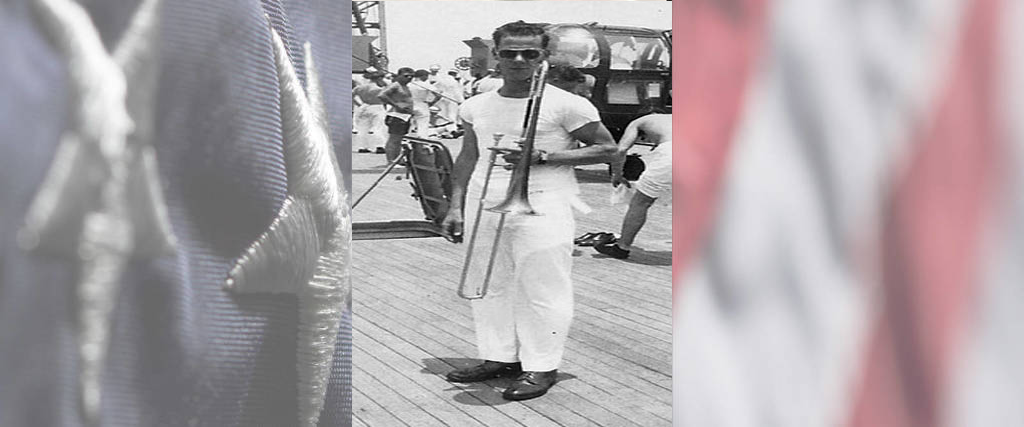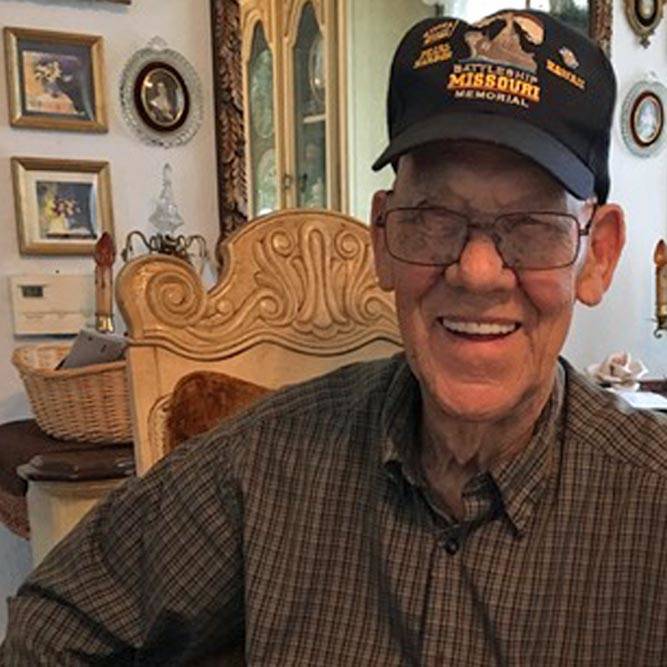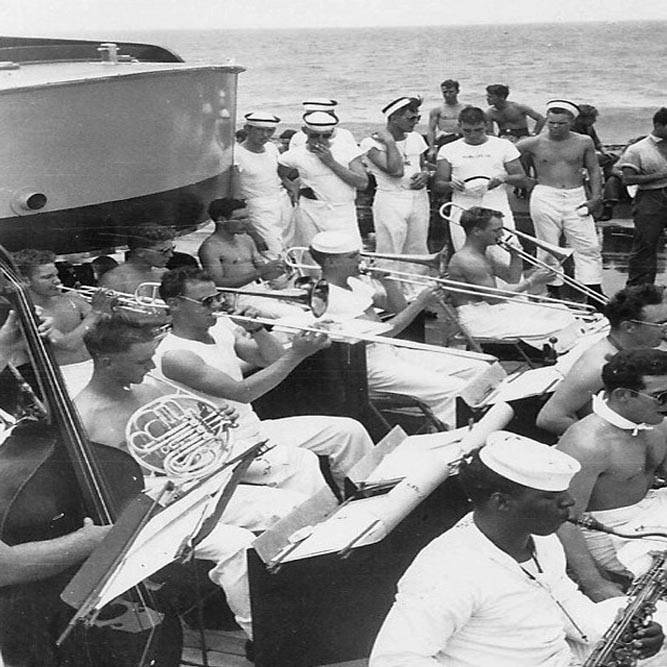U.S. Navy Korean War Park Ridge, IL Flight date: 07/11/18
By Wendy L. Ellis, Honor Flight Chicago Veteran Interviews Volunteer
The big guns fired from the deck of the USS Missouri for three days and three nights straight. Sailors were lucky to get two hours of sleep before being called back on duty to load the massive 16” guns, and, continue their bombardment of enemy troops on the Korean coast. It was October of 1950 and the Missouri, the Navy’s only remaining active battleship, had arrived to help with the Korean conflict.
For MU3 Edward Kasan, the noise of the bombardment was a far cry from the dulcet tones of the trombone and euphonium he played every day as part of the battleship’s 16 piece band. “You couldn’t be on deck when the guns went off or the concussion would kill you,” said Kasan. “An alarm would go off when they were about to fire the guns, and everyone would run inside.”
Kasan had enlisted in the Navy in 1948, just out of high school. His years in the band at Gage Park High School in Chicago earned him an assignment to the Navy’s music school in Washington DC where he spent six months learning to be a military musician. “It’s a different kind of music than I was used to,” said Kasan. “They play a lot of marches.” By 1949, with Basic Training and music school behind him, Kasan was assigned to the USS Missouri, nicknamed “Big Mo.”
Although trained to load shells into the big guns, Kasan was never called on to do so. His chief duty was to perform in the ship’s band. Every day band members hit the chow line early at lunch, then set up to entertain the other sailors as they ate. When docked in peaceful ports, the band often took part in land-based activities like parades, holiday celebrations and playing at officer’s clubs. Kasan’s first few months on board were peaceful ones, with R&R trips to Cuba. Then North Korea invaded South Korea, and things changed.
It was President Truman’s affection for the Missouri, named after his home state and christened by his daughter, that kept the big battleship from being decommissioned like so many others at the end of WWII. With the only active 16-inch guns in the fleet, General Douglas MacArthur wanted Big Mo to help with his upcoming invasion of North Korea at the port of Incheon. So important was the ship’s involvement in the planned mid-September attack that the resupplied Missouri sailed, despite reports of bad weather.
The ship sailed right into a hurricane off the coast of Florida. ”It was a bad one,” said Kasan. “We went 35 knots straight through it. There were a lot of men from Great Lakes onboard that got really sick. We had two and a half million dollars in damage to the ship.” Big Mo squeezed through the Panama Canal and made its way to Hawaii for a week’s worth of repairs, before finally heading to the Korean war zone. But the Battle of Inchon went on without them.
Although too late for Inchon, the Missouri took up bombardment of transportation lines and troops along the Korean coastline. Not long after, China entered the conflict on the side of North Korea. Just before Christmas, Chinese troops surged forward, attempting to surround UN troops retreating from Chosin Reservoir while making their way to the beaches at Hungnam. Two miles offshore, the Missouri’s big guns came to the rescue.
“The First Marine Division was coming down to the shore with Chinese troops coming after them,” said Kasan. “We set up a perimeter of shelling all the way around them, so when they got to the beach, they could get onto our ships. We had spotters telling us where the troops were. There were helicopters in the air, waiting for bomber pilots who had to ditch their planes and couldn’t make it back to their ships. You could only stay in the water a couple minutes, it was so cold.” The rescue became known as the Miracle of Christmas.
One of the most memorable events for Kasan was playing for Bob Hope when he came to entertain the sailors aboard the Missouri about a month after they arrived in Korea. “Les Brown and his Band of Renown couldn’t make the trip, so our band played for Bob Hope and Marilyn Maxwell,” said Kasan. “I felt great about that.” Through both quiet and chaos, Kasan knows the band was a morale booster for everyone on board Big Mo.
Kasan didn’t continue with his music when he got home in 1952. “I didn’t want to travel with a band,” he says. Instead he put in a few years of college, met and married his wife of 61 years, Barbara, and started a family. He now boasts proudly of his 7 children, 14 grandchildren and 4 great-grandchildren.
Thank you for your service, Edward J. Kasan …and as Bob Hope always said, “thanks for the memories!” Enjoy your well deserved Honor Flight!





